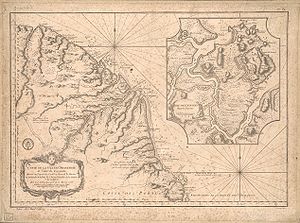History of French Guiana
The history of French Guiana (French: Guyane française) dates back to the time of the discovery of America.
Inhabitants before colonization
Guyane was originally inhabited by tribes of Carib and Arawak Indians, mainly, and small groups of Galibi, Swivel, Palikour, Waiampi and Wayana.
Arrival of Europeans
In 1498, Guyane was first visited by Europeans when Christopher Columbus sailed to the region and called it the "Land of the Pariahs".
A century later Grand Duke Ferdinand I de' Medici made the only Italian attempt to create colonies in America.
For this purpose, in 1608 the Grand Duke Ferdinand I organized an expedition to the north of Brazil, under the command of the English captain Thornton and with the supervision of sir Robert Dudley. The main reason was to develop the precious wood trade from the Amazon to Renaissance Italy, creating a colonial base between the Spanish and Portuguese possessions in North Atlantic South America. Unfortunately Thornton, on his return from the preparatory voyage in 1609 (he had been in the Amazon), found Ferdinand I dead and the whole project was annulled by his successor Cosimo II.
French colonization: 17th and 18th centuries
In 1604 King Louis XIV sent thousands of French colonists to Guyane who were seduced there with stories of the legendary El Dorado with lots of gold and easy fortunes to be made. Instead, they found a land filled with hostile natives and tropical diseases. A year and a half later, only a few hundred survived. They fled to three small islands that could be seen from the shore and called them the Îles de Salut (or "Islands of Salvation"). The largest was named Isla Real, the other San José (after the patron saint of the expedition), and the smallest of the islands, surrounded by strong currents, Île du Diable (the infamous 'Devil's Island';). When the survivors of this failed expedition returned home, the terrible stories they told of the colony left a lasting impression on France.
In 1794, after Robespierre's death, 193 of his followers were sent to Guyane. In 1797 the republican general Pichegru and many deputies and journalists were also sent to the colony. When they arrived, they found that only 54 of the 193 deportees sent three years earlier survived; 11 had escaped, and the rest had died of diseases and tropical fevers. Pichegru was able to escape to the United States and then returned to France, where he was eventually executed for plotting against Emperor Napoleon Bonaparte.
19th century: The penal era and African slaves
Later, slaves were brought from Africa and plantations were established along the rivers free of disease. Exports of sugar, timber, cayenne pepper, and other spices brought some prosperity to the colony for the first time. Cayenne, the capital, was surrounded by plantations, some of which held several thousand slaves.
In 1848, France abolished slavery and ex-slaves fled into the jungle establishing communities similar to those that had been stolen from them in Africa. They formed a kind of buffer zone between the Europeans who settled along the coast and major rivers, and the unconquered and often hostile Native American tribes in the interior regions. Without the availability of slave labor, the plantations were taken over by the jungle and the planters ruined.
In the 1850s, loads of Indians, Malays and Chinese were brought to work on the plantations but instead set up shop in Cayenne and other towns.
In 1852, the first loads of chained convicts arrived from France. In 1885, to get rid of habitual criminals and increase the number of settlers, the French parliament passed a law that anyone, whether male or female, who had more than three theft sentences of more than three months each, would be sent to Guyane as a relegate. These relegates were kept in prison there for a period of six months after which they were released to become inhabitants of the colony. However, this experiment was a failure: the prisoners were unable to earn a living working the land, so they were forced to commit crimes again or eke out a living until death. In fact, being sent to Guyane as a relegate was a life sentence, and usually a short one, since most relegates died quickly of disease and malnutrition. In 1940, Guyane declared himself in favor of Marshal Pétain, joining the Free France of March 1943.
20th century: French Department
Guyane became an overseas department of France on March 19, 1946.
The infamous penal colonies, including Devil's Island, were formally closed in 1951. First, only released prisoners who could afford the fare for their passage back to France were allowed to return home, so Guyane was flogged after the official closure of prisons by numerous released prisoners who led an aimless existence in the colony.
Back in 1954, the remaining ex-prisoners were finally repatriated to France, except for a horrible group of men gone mad. These poor unfortunates were kept in a poorly ventilated concrete building with a tin roof in sweltering hot conditions until they finally died.
Visitors to the site in December 1954 were deeply affected by the conditions and the constant screaming of the cell block, which had few ventilation slits in the tops of the walls under the ceiling. Food was pushed and bodies removed once a day.
Since 1954 there has been little economic growth. Guyane is heavily dependent on imports for food and fuel, and unemployment is chronically high. The only major development has been the establishment of a satellite launch base at the Center Spatial Guyanais, Kourou in 1964. This has provided limited local employment, but mainly foreign technicians, and the hundreds of soldiers stationed in the region to prevent possible sabotage, bring some cash into the local economy.
